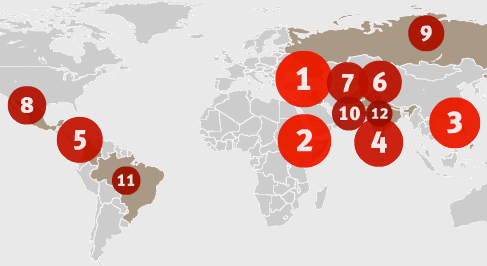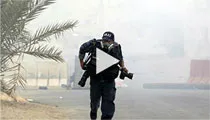Nepal’s ruling coalition failed to meet the Supreme Court’s May deadline to complete a constitution, dissolving the legislature amid political rifts that left the republic’s leadership in doubt. Nationwide strikes by political activists and ethnic minority groups advocating federalization resulted in journalists’ being harassed and attacked for perceived negative coverage. The majority Maoist party-controlled magazine Lal Rakshak called Kanak Mani Dixit, director of Himal Media publishing group, a “people’s enemy” for his criticism of the party’s violent tactics. The government moved to classify 140 categories of information relating to politics and the judiciary. The Supreme Court temporarily stayed implementation of the new classifications in February; a decision was pending in late year. Police arrested some journalists’ assailants but murder investigations stalled, keeping Nepal on CPJ’s Impunity Index of countries where journalists are murdered regularly and killers go free. An international media mission, which included CPJ and other global press freedom groups, met with Prime Minister Baburam Bhattarai in February to demand effective prosecution for past slayings and refine press freedom safeguards in the draft constitution.
Nepal
» General strikes cripple nation and foster anti-press violence.
» Government moves to classify 140 information categories as secret.
Nepal’s ruling coalition failed to meet the Supreme Court’s May deadline to complete a constitution, dissolving the legislature amid political rifts that left the republic’s leadership in doubt. Nationwide strikes by political activists and ethnic minority groups advocating federalization resulted in journalists’ being harassed and attacked for perceived negative coverage. The majority Maoist party-controlled magazine Lal Rakshak called Kanak Mani Dixit, director of Himal Media publishing group, a “people’s enemy” for his criticism of the party’s violent tactics. The government moved to classify 140 categories of information relating to politics and the judiciary. The Supreme Court temporarily stayed implementation of the new classifications in February; a decision was pending in late year. Police arrested some journalists’ assailants but murder investigations stalled, keeping Nepal on CPJ’s Impunity Index of countries where journalists are murdered regularly and killers go free. An international media mission, which included CPJ and other global press freedom groups, met with Prime Minister Baburam Bhattarai in February to demand effective prosecution for past slayings and refine press freedom safeguards in the draft constitution.
With five unsolved journalist murders in the past decade, Nepal is among the worst nations worldwide in combating impunity, CPJ's Impunity Index shows. The index calculates unsolved journalist murders as a percentage of each country's population.

| 1. Iraq 2. Somalia 3. Philippines 4. Sri Lanka | 5. Colombia 6. Nepal 7. Afghanistan 8. Mexico | 9. Russia 10. Pakistan 11. Brazil 12. India |
Numerous journalists were harassed or attacked during nationwide strikes by minority groups advocating federalization along ethnic lines. Protesters called media coverage hostile and encouraged attacks on the press, according to the Federation of Nepali Journalists.
31 | Vehicles and motorcycles vandalized by protesters to prevent reporting and dissemination of news, the federation said. |
12 | Publications in western districts forced to close when a local version of the strike lasted more than two weeks, causing a newsprint shortage, the Kathmandu-based Freedom Forum reported. |
1,000s | Copies of national publications, including Kantipur and Annapurna Post, burned by minority Madhesi political activists in 2012. |
The authorities directed government employees to categorize 140 previously accessible types of information related to politics and the judiciary as secret on January 15, according to news reports. Critics said doing so could inhibit corruption investigations. The directive had yet to be implemented in late 2012, pending a Supreme Court hearing to consider civil society objections.
5 | Information categories previously classified as secret by the 2007 Right to Information Report. |
36 | Journalists detained for four hours for sporting black armbands in protest of the directive while covering a political event in January, press freedom groups reported. |
Maoist chairman Pushpa Kamal Dahal pressured Bhattarai in January 2012 to drop charges against cadres accused of the 2004 murder of Dekendra Thapa, according to Freedom Forum.
2007: | Maoist leaders distance themselves from Birendra Shah's kidnapping and murder by a renegade cadre. Yet they fail to take steps to bring the perpetrator to justice. |
2009: | The Maoist-led government directs the authorities to drop their investigation into the 2007 murder of Prakash Singh Thakuri. |

